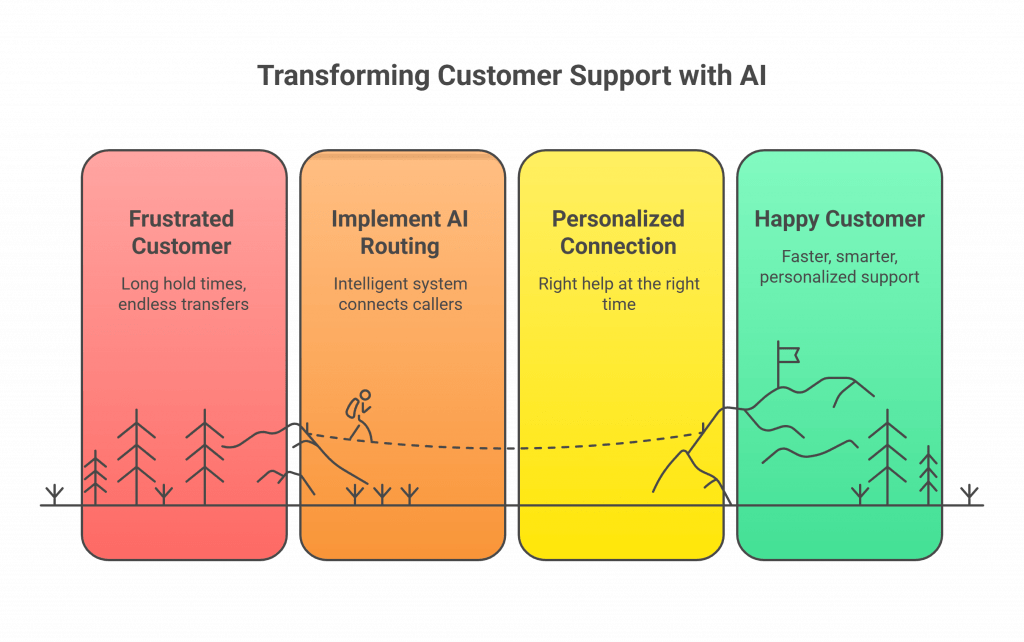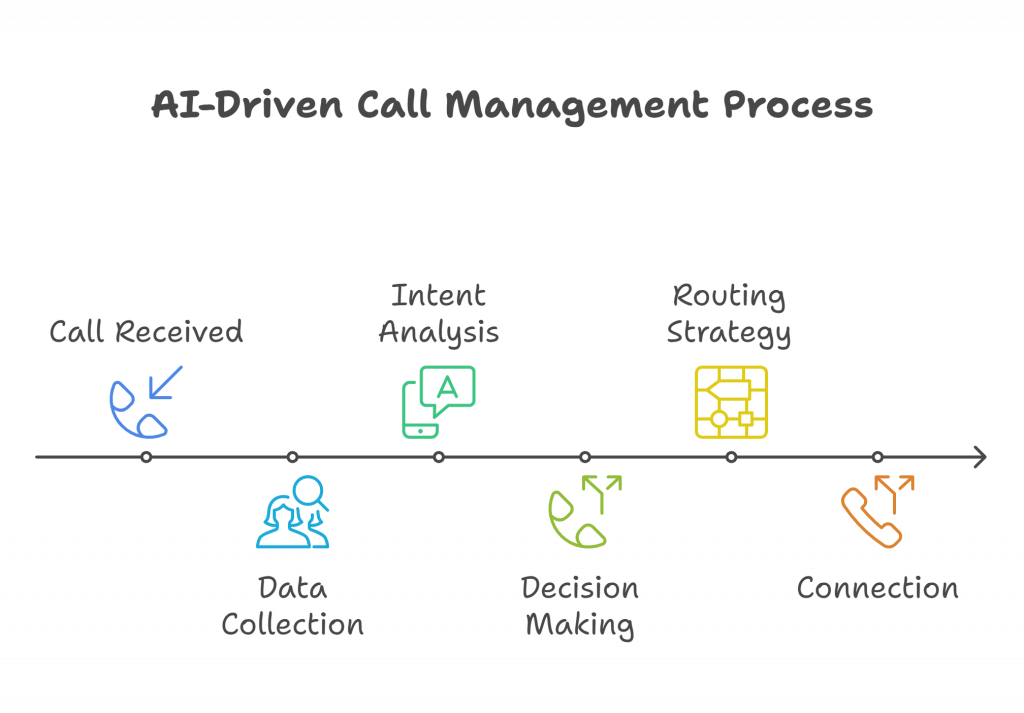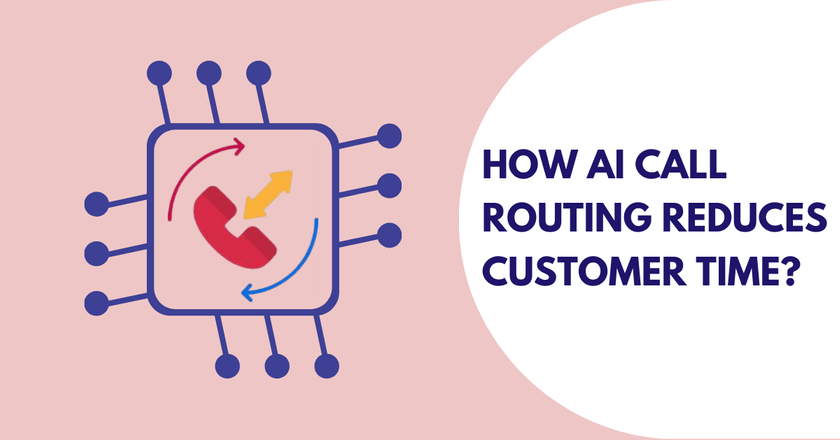If you belong to the customer support industry or team, you might be aware of the fact that customers don’t like to wait on hold. They don’t want to be greeted by a robotic IVR for so long. They don’t want to be stuck in the loop of music and endless transfers.
Research says, 76% of consumers still prefer phone support, but dislike the old-fashioned way of getting transferred from one agent to another.
In fact, if customer support is poor, 53% of customers are likely to abandon the brand entirely.
The solution? AI call routing technology!
It’s a smarter option for companies that want to improve their customer service. AI is a smarter, faster, and more personalized way to connect customers with the right help at the right time.
Let’s know more about what AI call routing is, and how it is better than traditional routing.

Why Traditional Call Routing No Longer Works?
Businesses have been relying on time-based rules, IVR menus, or skill-based routing in managing customer calls over the years. Such systems were okay when the number of calls was consistent and problems were basic.
However, customers in modern times have many more expectations. The new callers are expecting to be treated as individuals with quick answers and no duplication. However, in traditional routing, they have to:
- Wait on hold for long stretches,
- Navigate confusing Press 1 for Sales, Press 2 for Support menus,
- Repeat their story to multiple agents,
- Land in the wrong department altogether.
According to Harvard Business Review, a majority of customers come through the same pain points whenever they call customer support: more than half have to re-explain their issue, most of them are transferred unnecessarily, and approximately 60% say it takes moderate to high effort to resolve even a single query.
That is why the IVR software is so out of fashion, and 98% of callers attempt to avoid them.
That’s where AI call routing steps in.
What is AI Call Routing?
AI-based call routing involves artificial intelligence to connect every incoming call to the most appropriate solution path, be it a voice AI agent, human specialist, or even a callback.
Unlike inflexible IVR menus, AI systems read and comprehend natural language, recognize context, and take real-time decisions. They draw from:
- Customer intent and sentiment (is the caller frustrated, calm, or urgent?)
- Historical data (previous tickets, purchase history, or account details)
- Agent availability and skills (who’s free, who has expertise in this issue)
- Business priorities (VIP customers, high-value accounts, or urgent cases)
In other words, AI doesn’t just ask, Which department?; it also asks, What exactly does this person need, and who or what can solve it best right now?
AI is trained in such a way that these systems learn from every interaction and upgrade themselves with each call.

Verloop
Starting Price
Price on Request
How Does AI Call Routing Actually Work?
The process might seem sci-fi, but it is really simple:

- Call qualification – Once a call is received, the AI system greets the customer and starts collecting data like their phone number, voice tone, reason why they have called, and information related to their past interactions.
- Intent analysis – With the help of natural language processing (NLP), AI comprehends what the caller is saying. If a caller says, I want to upgrade my plan, the AI quickly detects this as a sales-related intent and routes the call to the sales team.On the other hand, if the customer says, I need to cancel my subscription, it’s flagged as a retention or cancellation request and routed to the appropriate department trained to handle such cases.
- Smart decision-making – In case the question is basic and repetitive, like a status on an order, the AI voice agent can answer it immediately. When the system identifies frustration, urgency, or complexity, the customer is transferred to a human agent, often during a conversation. But it maintains and carries over all context to eliminate the need to start over.
- Routing strategy and connection – The AI chooses the most appropriate route: a direct transfer, a callback, or an appointment with a particular expert. The beauty of this system is that it blends the human touch with automation, which transitions pretty easily between both.
Why Businesses are Turning to AI Call Routing?
Companies adopting AI-powered routing are already seeing striking improvements.
Studies report:
- 60% drop in wait times after switching to AI-driven systems,
- 25% increase in customer satisfaction,
- 1.2 hours of productivity saved per agent, per day, which adds up to an entire extra shift regained per week.
This efficiency not only helps customers, but it also changes the work environment of agents. They no longer have to sink into repetitive questions but are instead able to devote their attention to more complex, significant questions.
Deloitte even discovered that companies implementing AI are 35% less likely to experience overwhelmed agents. This is a massive retention boost in call centers that have high turnover rates.

Retell AI
Starting Price
Price on Request
AI Call Routing Across Industries
Here are a few places where AI-powered call routing is already making waves:
1. Healthcare
One of the most time-consuming problems in healthcare is scheduling appointments. Almost 88% of arrangements are carried out over the phone, but with outdated systems, this usually results in careless arrangements and missed appointments.
Smart routing helps patients get to the right department quickly with the help of AI voice agents. The use of conversational AI has allowed providers such as Medbelle to increase their successful scheduling by 60%.
2. Financial Services
Banks and insurers receive thousands of calls per day. By analyzing customer profiles, call history, and urgency, AI ensures that a customer disputing fraud doesn’t waste time in a generic queue. Predictive routing puts them in synch with the fraud experts right away, resulting in better first call resolutions and fewer call hang-ups.
3. E-commerce & Retail
In online retail, the questions shoppers ask are mostly the same- Where is my order? How do I exchange this? These can easily be addressed by Voice AI agents. The ones with more complicated refunds or complaints are sent to the human personnel. This decreases queue backlogs and can also help it scale support as the seasons change.
4. Contact Centers
Agent burnout is a huge issue with staff turnover rates frequently above 30-40 per cent per year. AI call routing in contact centers ensures the distribution of work is equal, preventing duplication in assigned tasks.
Benefits Beyond Faster Calls
Although speed is the most obvious advantage of AI call routing, there are more benefits that could count:
- Personalized Experiences: Customers feel relieved that they do not have to tell their story over and over again. VIPs are even routed to senior agents so that they are handled immediately.
- Less Call Abandonment: Improved queue management techniques and callback solutions result in fewer people hanging up in anger.
- Reduced expenses: A smaller number of routine queries could reduce labor costs. According to a UK study, phone calls cost more than six pounds each, but chat interactions driven by AI cost a few pennies.
- Omnichannel Support: Modern AI routing enables support across all channels: phone, chat, email, and apps.
- Improved Data Insights: Each call is turned into an insightful data point. It enables businesses to have better visibility of customer demands, agent performance, and trends.

Synthflow
Starting Price
$ 29.00
How to Get Started with AI Call Routing?
Is your business still on the old school IVR menus? If yes, it is high time to change your call stream.
The shift to AI call routing consists of three major steps:
- Check what you need: Determine what your existing routing does not address, as well as customers: long wait times, frequent transfers, or low first-call resolutions.
- Select the appropriate platform: Find customer support software that is compatible with the CRM, automatically handles natural language, and provides a balance between AI and humans.
- Educate your workforce: AI is an added advantage to your employees. Train employees to use AI-integrated tools and the insights they deliver.
Providers such as Retell AI, Verloop.io, and Synthflow AI already provide such advanced features. These are dynamic routing prompts, context-oriented automation, and multi-language support. The trick is to get one that best suits your customer base and expansion objectives.
Final Thoughts
Every interaction matters for customer support, as they want to resolve the issue so that it doesn’t occur again. But customers don’t want to wait, and this leads to negative experiences.
A single negative experience will cost you half of your customer base, whereas a single good one could give you a lifetime of (loyal) customers.
AI call routing combines speed, personalization, and intelligence to make every customer feel heard and assisted with less effort.
And as we walk further into 2025, we can be sure that the brands that succeed are those whose phone lines not only don’t just ring but get heard.
Mehlika Bathla is a passionate content writer who turns complex tech ideas into simple words. For over 4 years in the tech industry, she has crafted helpful content like technical documentation, user guides, UX content, website content, social media copies, and SEO-driven blogs. She is highly skilled in... Read more





























